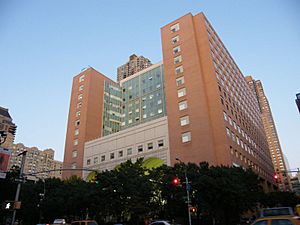Mount Sinai West facts for kids
Quick facts for kids Mount Sinai West |
|
|---|---|
| Mount Sinai Health System | |

Mount Sinai West
|
|
| Geography | |
| Location | 1000 10th Avenue, Manhattan, New York, United States |
| Coordinates | 40°46′12″N 73°59′15″W / 40.7700°N 73.9876°W |
| Organization | |
| Funding | Non-profit hospital |
| Hospital type | Teaching |
| Affiliated university | Icahn School of Medicine at Mount Sinai |
| Network | Mount Sinai Health System |
| Services | |
| Emergency department | Yes |
| Beds | 514 |
Mount Sinai West is a large hospital in the Midtown West neighborhood of Manhattan, New York City. It first opened in 1871 with the name Roosevelt Hospital. Today, it is part of the Mount Sinai Health System and works with the Icahn School of Medicine at Mount Sinai to teach new doctors.
The hospital has 514 beds for patients. It offers many different kinds of medical care. These include surgery for the mouth and jaw, bones, hands, and more. It also has departments for neurology (the brain and nerves), having babies, and a busy emergency department.
Mount Sinai West is known for its excellent care. It has special certifications for hip and knee replacement surgery. The hospital is also a top-level center for newborn babies who need extra care, a stroke treatment center, and a special program to help victims of assault.
Contents
History of the Hospital
The story of Mount Sinai West begins with a man named James Henry Roosevelt. In his will, he left his money to build "a hospital for the reception and relief of sick and diseased persons." After more money was raised, the hospital was built.
Roosevelt Hospital officially opened on November 2, 1871. A plaque at the hospital honors its founder. It calls him "a true son of New York, the generous founder of this hospital."
New Buildings and Changes
Over the years, the hospital grew and added many new buildings. A special building for surgery, the William J. Syms Operating Theatre, opened in 1892. New wings for patients, a home for nurses, and modern research buildings were also added.
In the 1990s, a new 13-story main hospital building was built. To make room for it, some of the older parts of the hospital were torn down. The old emergency room was famous because it was where John Lennon was pronounced dead in 1980. It was also used for filming the outside of the hospital in the TV show Seinfeld.
The oldest part of the hospital that still stands is the Syms Operating Theater. It was one of the first in the world designed for aseptic surgery, which means it was kept extremely clean to prevent infections. It is now a protected New York City landmark.
Becoming Mount Sinai West
In 1979, Roosevelt Hospital joined with another hospital, St. Luke's Hospital. They became St. Luke's–Roosevelt Hospital Center. In 2013, this center became part of the large Mount Sinai Health System.
In 2015, the hospital was renamed Mount Sinai West. In 2020, the St. Luke's part of the hospital was renamed Mount Sinai Morningside, and the two hospitals became separate again.
Famous Doctors of the Past
Many important doctors have worked at the hospital. They made great contributions to medicine.
- William Stewart Halsted was a famous surgeon who developed new, safer ways to perform operations.
- Robert Abbe was the first doctor in America to use radium to treat cancer.
- Charles McBurney was a top surgeon who created a special type of cut for appendectomy (appendix removal) surgery. He also introduced the idea of surgeons wearing rubber gloves to keep things clean and prevent infections.
Hospital Services
Mount Sinai West provides a wide range of medical services to the community.
Care for Mothers and Babies
The hospital has a busy maternity unit for delivering babies. The number of babies born at Mount Sinai West grew by 28% between 2016 and 2019. Because of this, the hospital has worked to update and expand its maternity facilities to care for more families.
Emergency Room
The emergency department is open 24 hours a day. It has teams of doctors ready to treat serious problems like strokes and heart attacks at any time. The emergency room also has doctors who are specially trained to care for children who are sick or injured.
Notable Patients
Some well-known people have been treated at the hospital's emergency room.
- John Lennon, a famous musician, was brought to the hospital in 1980 and was pronounced dead there.
- Brian Thompson, a business executive, was pronounced dead at the hospital in 2024.
Teaching New Doctors
Mount Sinai West is a teaching hospital. This means it helps train new doctors in many different medical fields. The hospital has 30 residency programs where doctors get hands-on experience after finishing medical school.
The program for Internal Medicine is one of the biggest in New York. It uses modern teaching methods, including a "Simulation Lab" where residents can practice their skills in a safe environment.
See also
- Architecture in New York City
- Healthcare in New York City
- List of hospitals in New York City
- List of hospitals in New York

